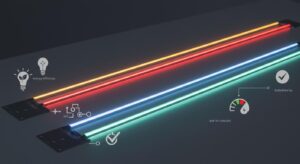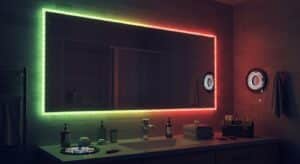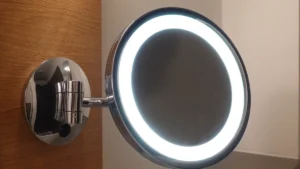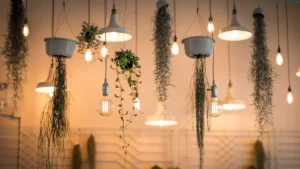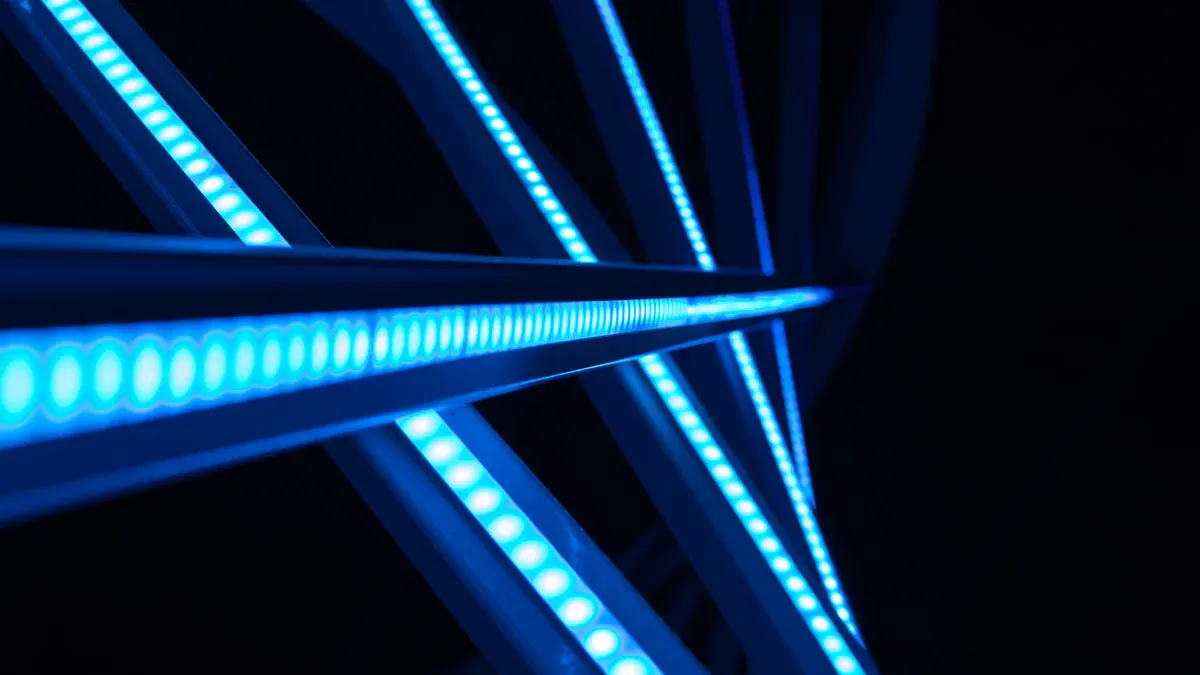
High quality LED strip lights are a must-have for 2025. They are flexible, useful, and save energy. These lights mix style with practical use to meet modern needs. As global energy use grows by 4.6%, energy-saving lights like high quality LEDs help cut costs and pollution.
Buying high quality LED strip lights means they work well for a long time. Unlike cheap ones, high quality LED strips use better materials and technology. They provide steady brightness, last longer, and display colours accurately. They can last 25 times longer than traditional bulbs, making them excellent for homes and businesses.
The UK Department of Energy states that LEDs use 75% less energy. This makes them essential for eco-friendly living.
Key Takeaways
Good quality LED strip lights use less energy and last longer. They are a great option for homes and businesses.
Pick LED strips with at least 450 lumens per foot. Also, ensure they have 36 LEDs per foot for bright and even light.
Get strips with strong sticky backing for easy setup. You can also use mounting clips to keep them in place.
Check the Colour Rendering Index (CRI) to see colours correctly. A CRI of 95 or more gives bright and natural-looking light.
Make sure the strips work with smart home systems. This makes control easier and saves energy with automation.
Key Features of High Quality LED Strip Lights
LED Type and Brightness Levels
When picking high quality LED strip lights, knowing the LED type and brightness is important. Brightness is measured in lumens, showing how much light is given off. Good quality LEDs should have at least 450 lumens per foot or 1500 lumens per metre. This ensures they are bright enough for decoration and practical use.
The number of LEDs affects brightness and even lighting. Top-quality strips usually have 36 LEDs per foot (120 LEDs per metre). This gives steady and bright light. Each foot should use at least 4 watts of power. This ensures the lights work well without straining the circuit.
Specification | Value |
|---|---|
Lumens per foot | At least 450 lumens/foot |
Lumens per metre | At least 1500 lumens/metre |
Power draw per foot | 4 watts/foot or more |
LED density | 36 LEDs/foot (120 LEDs/metre) |
Maximum LED drive | Not more than 0.2 watts/LED |
Choosing the right LED type, like SMD (Surface-Mounted Device) LEDs, is key. These LEDs are brighter, use less energy, and show colours better. They are also long-lasting and work well for many uses.
Circuit Board Quality and Durability
The circuit board is the main part of an LED strip light. Its quality decides how long and well the lights will work. Good LED strips use boards that meet standards like LM-80 and TM-21. These standards check and predict how long LEDs will last under certain conditions.
Standard | Description |
|---|---|
LxByCz | Shows how long LEDs last based on light and failure rates. |
LM-80 | A test to check LED lifespan under set conditions. |
TM-21 | A method to predict LED lifespan using LM-80 results. |
For strong and reliable lights, choose strips with sturdy SMD LEDs from trusted brands. These LEDs are bright, keep colours consistent, and resist damage. Voltage stability is also vital. A steady power supply stops flickering and keeps the lights working smoothly.
Good circuit boards also protect against dust and moisture. Many high-quality strips come with warranties, showing the maker trusts their product’s durability.
Adhesive Backing for Easy Installation
Installing LED strip lights should be simple. Most good-quality strips have adhesive backing, making it easy to stick them onto surfaces. This is great for DIY projects as no extra tools are needed.
Not all adhesives are the same. The best strips use strong adhesives that stick well, even on rough surfaces. For humid or hot areas, choose strips with better adhesives or extra mounting options.
Adhesive-backed strips can also be customised. You can cut them at marked spots to fit your project perfectly. Whether for under-cabinet lighting, highlighting designs, or creating mood lighting, these strips are very flexible.
Tip: Clean the surface before sticking the strips to help the adhesive hold better. For long-term use, add mounting clips for extra support.
Colour Accuracy and Temperature Options
Top-quality LED strip lights provide accurate colours and flexible temperature choices. These features help set the mood and make colours look natural. To check colour accuracy, look at the Colour Rendering Index (CRI). A CRI of 95 or more ensures colours appear bright and realistic. This is perfect for places like photo studios, shops, or home decoration.
Temperature options make LED strips more useful. The best ones offer a range from 2700K to 6500K. Warm tones (2700K–3000K) are cosy, while cool tones (5000K–6500K) suit work areas.
Colour Rendering Index (CRI): 95 or higher
Colour Temperature Range: 2700K to 6500K
Tip: Use warm tones for relaxing spaces like bedrooms. Cool tones are better for offices or study areas needing focus.
Some LED strips let you adjust the temperature. You can switch between warm and cool tones as needed. This makes them great for rooms used for different purposes, like living rooms that also serve as workspaces.
Smart Control and Customisation Features
New LED strip lights come with smart controls for easy use. You can change brightness, colours, and patterns using apps or voice commands. They work with systems like Alexa, Google Home, or Apple HomeKit for smooth control.
Customisation lets you set lighting to match your style. You can schedule lights, dim them automatically, or create fun effects for events. Some models even sync with music, changing lights to match the beat.
Callout: Smart controls save energy by turning lights off when not needed. This reduces wasted electricity.
For creative users, programmable LED strips offer many options. You can make unique designs or connect them to smart home systems. Whether for parties or work, smart LED strips fit your needs perfectly.
Benefits of Advanced Technologies in LED Strip Lights
Waterproof and Weatherproof Designs
Top-quality LED strip lights now have waterproof and weatherproof features. These make them great for both indoor and outdoor spaces. They are protected from water, dust, and heat, so they last longer. You can safely use them in bathrooms, kitchens, gardens, or patios without worrying about damage.
Choose strips with an IP65 rating or higher. This means they resist water splashes and dust. For areas with heavy rain, pick IP67-rated strips. These can handle being briefly underwater. These features help the lights last longer, saving you money on replacements.
Tip: Use weatherproof connectors when installing waterproof LED strips outside. This keeps them working well.
Energy Efficiency and Longevity
New LED technology makes these lights very energy-efficient and long-lasting. They use up to 75% less energy than old-style lights but are still very bright. This helps lower electricity bills and is better for the planet.
LED strip lights can last over 50,000 hours. This is much longer than regular bulbs, which only last 1,000 to 2,000 hours. Their long life makes them a smart and cost-saving choice.
Benefit | LED软灯带 | Traditional Lighting |
|---|---|---|
Energy Consumption | Uses 75% less energy | Uses more energy |
Lifespan | Over 50,000 hours | Around 20,000 hours |
Customisation of Light | Adjustable for plant growth | Limited options |
Integration with Technology | Smart controls available | Manual controls only |
Callout: LED strips with high efficiency, like 134 lm/W, give bright light and are eco-friendly.
Dimmable and Programmable Options
Dimmable and programmable LED strips give you great control. You can change brightness to match any mood or event. Timer settings let you schedule when lights turn on or off, saving energy.
Some models have fun features like colour changes or syncing with music. These are perfect for parties or celebrations. Advanced systems like DALI and DMX offer smooth dimming and energy savings.
Adjust brightness to suit your mood or activity.
Timers help save energy by controlling light usage.
Wireless options make setup and control easy for everyone.
Tip: Connect programmable LED strips to smart home systems. This lets you control them with apps or voice commands.
Integration with Smart Home Systems
Top-quality LED strip lights now work well with smart home systems. You can easily control them using voice, apps, or automation hubs. This makes life easier and lets you customise your lighting.
Smart LED strips work with platforms like Amazon Alexa, Google Home, and Apple HomeKit. By linking your lights to these systems, you can change brightness, pick colours, or set schedules. For example, you can dim lights at night or switch to bright tones in the morning.
Tip: Use location-based features to turn lights on or off automatically. This saves energy and boosts security.
Benefits of Smart Integration
Voice Commands: Control lights without touching anything.
Lighting Schedules: Set lights to match your daily plans.
Save Energy: Turn off lights remotely to cut power use.
Create Scenes: Make lighting setups for relaxing, working, or fun.
Some systems also work with IFTTT (If This Then That). This lets you set triggers, like syncing lights with weather or alerts. For instance, lights can glow blue when it rains or flash for important emails.
Callout: Smart features make your home more stylish and functional.
When buying LED strips, check if they fit your smart home system. Choose products with clear guides and good support for easy setup.
How to Choose the Right LED Strip Lights
Know Your Purpose (e.g., decoration, work, or general lighting)
Start by deciding why you need LED strip lights. Different uses need different brightness, colours, and features. For decoration, like highlighting walls or creating moods, pick strips with adjustable colours and dimming. These let you change the look for any event.
For work lighting, like kitchen counters or desks, focus on brightness and clear colours. Neutral white light (4000K–5000K) helps you see better without hurting your eyes. For general lighting, warm tones (2700K–3000K) make spaces feel cosy and welcoming.
Use Area | Best Colour Temperature | Suggested Brightness | CRI Value |
|---|---|---|---|
Kitchen | 3000K | 150-400 lux | At least 95 |
Hallway | 3000K | 100-150 lux | N/A |
Dining Room | 2700K-3000K | 150-500 lux | At least 96 |
Study/Office | 4000-5000K | N/A | N/A |
Stairs/Landings | 3000K | 100 lux | N/A |
Tip: Match the light type to the space. Use bright, cool lights for work areas and soft, warm lights for relaxing spots.
Measure Length, Brightness, and Power Needs
Think about how long, bright, and powerful your LED strip lights should be. Measure the area first to buy the right length. This avoids gaps or extra pieces.
Brightness, shown in lumens, tells how much light the strip gives. For normal use, aim for 450 lumens per foot. COB LED strips are brighter (up to 1,500 lumens for 10W) than regular SMD strips.
Feature | COB LED Strips | Standard SMD LED Strips |
|---|---|---|
Brightness (10W) | 1,500 lumens | 1,000 – 1,200 lumens |
Energy Efficiency (lm/W) | 150 lm/W | Below Energy Star benchmark |
Heat Dissipation Efficiency | 3x faster than SMD | Slower heat dissipation |
Lifespan | 70,000+ hours | Lower lifespan |
Colour Rendering Index (CRI) | 90-97 | Lower CRI |
Power depends on the strip’s length and LED density. Make sure your power supply matches the strip’s voltage and wattage. This stops flickering or overheating. Tools like light meters can check brightness and confirm the strip meets your needs.
Tool Used | Unit | What It Does |
|---|---|---|
Light Meters (Lux Meters) | Lux | Measures light on surfaces, useful for real-world checks. |
Integrating Spheres | Lumens | Measures total light output, used for testing quality. |
Goniophotometers | Candela | Tests light intensity and beam spread, good for design planning. |
Simulation Software | N/A | Models light levels and spread using files for accurate predictions. |
Note: Overloading power supplies can cause problems. Always check the product details for compatibility.
Look at Quality and Warranty
Good LED strip lights last longer and work better. Strong materials help them resist damage. Look for certifications like CE, RoHS, and UL. These show the product is safe and reliable.
Feature | What It Means |
|---|---|
Safety Checks | Certifications test for safety, including chemical and light effects. |
Meeting Standards | Certified strips follow global rules, ensuring they work well. |
Better Quality | Testing finds weak points, leading to improved products. |
Building Trust | Certifications from trusted groups make buyers confident in the product. |
A good warranty shows the maker trusts their product. High-quality strips often have warranties of two to five years. This protects your money and ensures help if something goes wrong.
Tip: Work with trusted sellers for better deals and service. Visiting trade shows can also help you learn about new products and trends.
Look for Certifications and Safety Standards
When buying LED strip lights, certifications and safety rules are very important. They show the product is safe, eco-friendly, and energy-efficient. Certified products lower risks like electrical problems, bad performance, or harming the environment.
Key Certifications to Know
Different areas have their own safety standards. Knowing these helps you choose wisely:
Region | Certification Standards |
|---|---|
EU | Low Voltage (LVD Directive), EMC Directive, RoHS, REACH |
North America | UL certification (U.S.), CSA certification (Canada), UL 588, UL 2108, UL 1598 |
Japan | PSE certification (round PSE voluntary, diamond PSE mandatory) |
International | IEC standards such as IEC 62471 (photobiological safety), IEC 61347 (drive power safety) |
Environmental | RoHS, REACH, WEEE |
Energy | Energy Star (U.S./Global), ERP Directive |
Special | IP protection levels (e.g., IP65, IP67), explosion-proof certification (e.g., ATEX) |
For example, CE marking in Europe or UL certification in North America ensures the product meets local safety rules. IP ratings like IP65 or IP67 mean the lights are safe from dust and water, making them good for outdoor use.
Tip: Look for certifications like RoHS and REACH. These ensure the product is safe for the environment and free from harmful materials.
Choosing certified LED strip lights means you get safe, high-quality products that last longer and work better.
Compare Pricing and Value for Money
It’s important to balance cost and quality when picking LED strip lights. Cheaper options might save money now but often fail quickly or perform poorly. Spending more on good-quality lights saves money over time because they last longer and work better.
What Affects Value?
Several things decide how valuable LED strip lights are:
Factor | Description |
|---|---|
Quality Assurance | Ensures the product meets standards, avoiding extra costs later. |
Compliance with Standards | Certifications like ISO prove the product is reliable and safe. |
Supplier Communication | Good communication with sellers ensures better quality control. |
Market Trends | The growing LED market shows rising demand for energy-saving lights. |
The global LED market is expected to grow to USD 168.87 billion by 2030. It will grow by 11% each year from 2023 to 2030. This shows more people want energy-saving lights, so it’s smart to buy products that match this trend.
Tips for Checking Prices
Compare energy efficiency by looking at lumens per watt (lm/W).
Check warranties and support services for long-term use.
Avoid very cheap lights without proper certifications or good materials.
Callout: Spending more on high-quality LED strip lights lowers repair costs and improves performance.
By comparing prices and value, you can find LED strip lights that fit your needs without giving up on safety or quality.
Common Mistakes to Avoid When Buying LED Strip Lights
Ignoring Power Supply Compatibility
Using the wrong power supply can harm your LED strip lights. Each strip needs a specific voltage and wattage to work properly. If the power supply doesn’t match, the lights may flicker, overheat, or stop working early. For example, pairing non-dimmable lights with PWM dimmers often causes unstable lighting.
To prevent this, check the voltage and wattage of your LED strips. Pick a power supply that gives 20% more wattage than needed. This extra power stops overloading and helps the lights last longer. If connecting multiple strips, add up their power needs and choose a suitable supply.
Tip: Buy a good-quality power supply with safety features like overcurrent and short-circuit protection. This keeps your lights safe and reliable.
Forgetting About Heat Management
Managing heat is key to keeping LED strip lights working well. Poor heat control can make LEDs hotter, causing them to lose brightness faster and wear out sooner. Aluminium PCBs cool better than FR-4 materials, keeping LED temperatures lower. Without proper cooling, LED temperatures can rise by 10°C, doubling the rate of brightness loss.
When setting up LED strips, avoid surfaces like wood or plastic that trap heat. Use aluminium profiles or heat sinks to help cool the lights. Strips with tightly packed LEDs get hotter at high power, so keep this in mind when choosing your lights.
Note: Good heat management improves performance and prevents problems like overheating or electrical shorts.
Picking the Wrong Colour Temperature
Choosing the wrong colour temperature can ruin the mood or purpose of a space. LED strips come in warm tones (2700K–3000K) and cool tones (5000K–6500K). Warm tones feel cosy, while cool tones are better for work areas. Using the wrong tone can make a room feel uncomfortable or less productive.
For instance, cool white lights in a bedroom may feel too harsh. Warm tones in an office might make it harder to focus. Match the colour temperature to the room’s purpose. Adjustable LED strips let you switch between tones, making them great for multi-use spaces.
Tip: Look for lights with a Colour Rendering Index (CRI) of 95 or higher. This ensures colours look bright and natural, improving the overall lighting experience.
Skipping Reviews or Ignoring Specifications
Not checking reviews or specifications can lead to bad choices. You might buy LED strip lights that don’t work as expected. Learning about the product and reading feedback helps you pick wisely.
Why Reviews Are Helpful
Reviews show how a product works in real life. They point out problems like flickering, weak adhesive, or wrong colour tones. Reading reviews helps you spot common issues and avoid bad brands. Check reviews on trusted sites like Amazon, Trustpilot, or lighting forums.
Tip: Look for reviews that match your needs. For example, if you want outdoor lights, focus on comments about waterproofing and durability.
Why Specifications Matter
Specifications tell you what the LED strip lights can do. Important details include lumens, wattage, colour temperature, and CRI. These numbers show if the lights are right for you. For example, a CRI under 80 may make colours look unnatural. Low lumens might leave your space too dark.
Specification | What It Means |
|---|---|
Lumens | How bright the light is |
Colour Temperature | Warm or cool light tones |
CRI | How true colours look under the light |
Wattage | Power use and compatibility |
Skipping these details can cause problems. For instance, buying a dim strip for work lighting won’t give enough brightness.
Callout: Compare specifications from different products to find the best one for your needs.
By checking reviews and specifications, you lower risks and get LED strip lights that work well and last long.
Future Trends in High Quality LED Strip Lights for 2025
AI and IoT Integration
AI and IoT are changing how LED strip lights work. These smart technologies make lights adjust to your needs and surroundings. For example, AI can learn how you use a room and change brightness or colour to save energy and make you comfortable. IoT lets you control lights with apps or voice commands, making it easy and convenient.
Real-world examples show how these features help. On busy city roads, smart lights use traffic data to change brightness, improving safety and saving energy. In rural areas, solar-powered lights with motion sensors light up only when cars pass by. These examples show how AI and IoT make LED lighting smarter and more eco-friendly.
Tip: Pick LED strip lights that work with systems like Alexa or Google Home for easier control and energy savings.
Sustainable and Eco-Friendly Materials
Eco-friendly materials are becoming popular in LED strip lights. Makers now use recyclable parts and energy-saving designs to protect the planet. LED strips use less power than old-style lights, making them great for people who care about the environment.
Experts say more energy-efficient and green LED products will be available by 2025. This shows people want products that help the planet. Choosing eco-friendly LED strips helps reduce waste and supports a cleaner future.
Callout: Look for LED strip lights with certifications like RoHS and REACH to ensure they are safe for the environment.
Modular and Customisable Designs
Modular and customisable LED strip lights are changing how spaces look and feel. These lights let you create unique designs that are both useful and stylish. The idea of ‘lines of light’ shows how easy it is to make eye-catching spaces with these lights.
Modular designs are flexible and simple to set up. LED strips can fit into different surfaces, making them great for creative projects. They offer bright, even lighting and many colour choices, improving how spaces look.
Benefit | Description |
|---|---|
Adaptability | LED strips fit into different surfaces, giving design freedom. |
Energy Efficiency | They use less power than older lights, helping the environment. |
Customisation | You can adjust designs to match your needs, improving experience. |
Aesthetic Enhancement | Bright colours and even lighting make spaces look better. |
Ease of Installation | Easy setup makes them perfect for many projects. |
Note: Modular LED strips last longer and need less upkeep, saving you money.
Innovations in Colour Rendering and Dynamic Lighting
New ideas in colour rendering and dynamic lighting have changed LED strip lights. These updates make colours look brighter and more natural. This improves how spaces look and feel. High-quality LED strips now have better Colour Rendering Index (CRI) values, often above 95. This makes objects look real and clear, perfect for art studios, shops, or homes.
Dynamic lighting adds more options. You can change brightness, colour temperature, and hues instantly. Some LED strips include tunable white technology. This lets you easily switch between warm and cool tones. It helps create the right mood, whether relaxing or working.
Modern LED strips also use RGBW (Red, Green, Blue, White) and RGBIC (Red, Green, Blue with Independent Control) systems. These give more colour choices and smoother changes. For example, RGBIC strips can show many colours at once. This makes them great for parties or special events.
Tip: Choose LED strips with app controls. You can set scenes, sync lights with music, or schedule changes automatically.
Advanced colour rendering and dynamic lighting make LED strips more useful and stylish. Picking these features gives you better lighting and a unique experience.
Picking high quality LED strip lights means they last longer. They can work for up to 100,000 hours, so you won’t need to replace them often. These lights use less energy, cutting electricity costs by up to 90%. This makes them a smart and eco-friendly option.
Choose lights based on your needs, like for decoration or work. Modular designs and smart features let you adjust the lights to your liking. Keeping up with new trends, like AI and eco-friendly materials, helps you buy lights that stay useful in the future.
Tip: Buying good-quality lights not only makes your space better but also helps the planet by using less energy.
FAQ
How bright should LED strip lights be?
The brightness you need depends on how you’ll use them. For decoration, 450 lumens per foot is enough. For work lighting, go for 800 lumens per foot. Always check the lumens to match your needs.
Can I cut LED strip lights to fit?
Yes, most LED strips can be trimmed at marked spots. These marks show where it’s safe to cut. Use sharp scissors or a blade carefully to avoid damage. If using outdoors, seal the cut ends to protect them.
How do I pick the right colour temperature?
Choose the colour temperature based on the room’s use. Warm tones (2700K–3000K) are cosy for bedrooms. Cool tones (5000K–6500K) are better for kitchens or offices. Adjustable strips let you switch tones for multi-use spaces.
Do LED strip lights work with smart home systems?
Many good LED strips connect to Alexa, Google Home, or Apple HomeKit. Check the product details to ensure compatibility. Smart features let you control lights with voice, set schedules, and automate tasks.
What certifications should I check for LED strip lights?
Look for certifications like CE, RoHS, and UL. These prove the lights are safe, energy-saving, and eco-friendly. IP ratings like IP65 or IP67 mean they resist dust and water, making them great for outdoor use.
See Also
Selecting The Perfect LED Strip Lights For Linear Lighting
Five Essential Tips For Choosing Quality LED Strip Lights
2024’s Best LED Strip Lights: A Feature And Price Review
